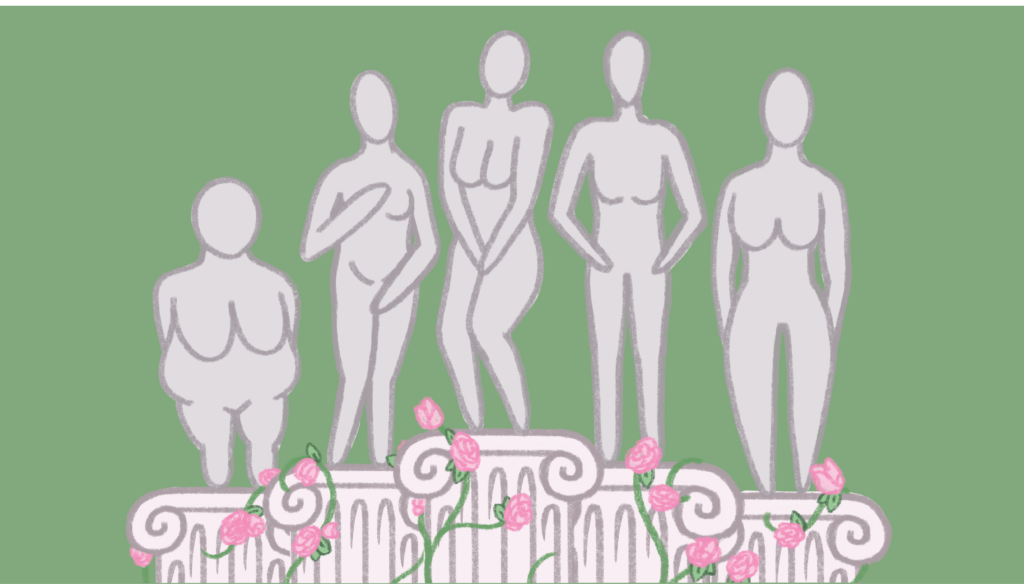The beauty in change
In the late 2010s, “slim-thick” took my world by storm. In 2017, I was 10 years old. I would admire the women in media, ranging from magazines to social media and even anime. I fell in love with their wide hips and the absurdly small waist that accompanied them. Despite having thick thighs and large butts, their stomachs were flat and toned. I admired their long eyelashes, plump lips, and even their slim face shape. I saw women like Kylie Jenner and Kim Kardashian and wanted to look exactly like them.
Because of the intense urge to resemble these women, my admiration quickly grew into comparison. In 2018, I began fifth grade. I didn’t like that my stomach wasn’t flat, so I constantly looked for solutions. For my new back-to-school clothing, I bought my first pair of high-waisted jeans ever. I was incredibly excited to hide my stomach, but when I put them on, I was met with the disappointment of natural hip-dips that became just another thing to hide.
As I grew older, my insecurities fluctuated with the ever-changing standards. With the influence of slim-thick, I hated that I didn’t have a thigh gap as well as my rounder face. I hated my straight eyelashes, my small eyes and my thin lips. I especially hated my stomach, which I continue to struggle with.
It wasn’t until 2023 that I realized something: no one ever told me that my stomach was too large, my lips thin, my hip-dips unsightly. No one told me that I was meant to look like the models in the magazines. So why did I still feel the pressure to uphold these standards?
I recently learned that each year a new trend begins and ends, only to reappear 2-3 decades later. Upon this discovery, I began researching. I found this cycle in the Y2K era: the re-emergence of low waisted rhinestone jeans, MMA elite prints on t-shirts and layered clothing. Alongside this renewal came the wave of 2000s body standards. Originating in the 1990s, “heroin chic” and the craving to be rail thin continued on.
The heroin chic trend of the late 1990s was characterized by dark undereye circles, pale skin, and most importantly being so thin you appeared malnourished. The goal was to look gaunt, whereas the slim-thick of the late 2010s was known as “all plump.” These two trends are night and day.
I found several instances in history where it was popular to be everything that is unpopular today. Chief among these are the past beauty standards in works of art resembling Venus, the Roman goddess of love and beauty.
The “Venus of Willendorf” is a small statue thought to be created over 25,000 years ago. The statue, sculpted by an unknown artist, resembles a stout woman with sizable breasts, broad hips, and a large, healthy stomach. There are no facial features visible. Historians say that she was modeled after beauty and symbolized fertility, as having body weight during the Stone Age was uncommon, and therefore more attractive.
To compare, 15th Century artist Sandro Botticelli painted “The Birth Of Venus.” The painting displays Venus rising out of the sea in a giant clam shell, completely nude. She has little visible fat on her stomach, smaller breasts and thinner hips. Her face is slim and symmetrical with thin eyebrows. She has barely visible lashes, and her lips are slender.
These works of art tell me that all types of bodies have been the beauty standard, and not just “slim-thick” during my lifetime. I realized that it hasn’t always revolved around being skinny, toned, smooth and perfect, as it does now. I question why so many feel pressured to fit the current beauty trends, despite them not lasting forever.
It’s human nature to follow the crowd — a phenomena embedded in our psychology: the bandwagon effect.
It’s taken me my entire life to realize that beauty standards are a social construct made powerful by human interaction. When I reflect on how chronically I compared myself to others, it feels unreal. I can’t believe that I was so mean to myself because I wasn’t born the way someone else was, or that I compared myself to someone who had gotten their body altered through surgery. I’ve been holding myself to unrealistic beauty standards and took it out on a body that has enabled me to live.
The journey to accepting that I am beautiful the way I am became easier when I realized that body types like mine were the standard once. Now, instead of shaming myself for not resembling the Kardashians, I’ve found parts of myself more beautiful because Marilyn Monroe also had them. Although it isn’t in a negative way anymore, I still compare myself to others. But slow motion is better than no motion, and I am incredibly proud of how far I’ve come.




